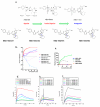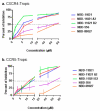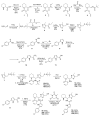Structure-Based Design of a Small Molecule CD4-Antagonist with Broad Spectrum Anti-HIV-1 Activity
- PMID: 26301736
- PMCID: PMC4676410
- DOI: 10.1021/acs.jmedchem.5b00709
Structure-Based Design of a Small Molecule CD4-Antagonist with Broad Spectrum Anti-HIV-1 Activity
Abstract
Earlier we reported the discovery and design of NBD-556 and their analogs which demonstrated their potential as HIV-1 entry inhibitors. However, progress in developing these inhibitors has been stymied by their CD4-agonist properties, an unfavorable trait for use as drug. Here, we demonstrate the successful conversion of a full CD4-agonist (NBD-556) through a partial CD4-agonist (NBD-09027), to a full CD4-antagonist (NBD-11021) by structure-based modification of the critical oxalamide midregion, previously thought to be intolerant of modification. NBD-11021 showed unprecedented neutralization breath for this class of inhibitors, with pan-neutralization against a panel of 56 Env-pseudotyped HIV-1 representing diverse subtypes of clinical isolates (IC50 as low as 270 nM). The cocrystal structure of NBD-11021 complexed to a monomeric HIV-1 gp120 core revealed its detail binding characteristics. The study is expected to provide a framework for further development of NBD series as HIV-1 entry inhibitors for clinical application against AIDS.
Figures





Similar articles
-
Design, synthesis, and antiviral activity of entry inhibitors that target the CD4-binding site of HIV-1.J Med Chem. 2012 May 24;55(10):4764-75. doi: 10.1021/jm3002247. Epub 2012 May 10. J Med Chem. 2012. PMID: 22524483 Free PMC article.
-
Binding mode characterization of NBD series CD4-mimetic HIV-1 entry inhibitors by X-ray structure and resistance study.Antimicrob Agents Chemother. 2014 Sep;58(9):5478-91. doi: 10.1128/AAC.03339-14. Epub 2014 Jul 7. Antimicrob Agents Chemother. 2014. PMID: 25001301 Free PMC article.
-
Design, synthesis and evaluation of small molecule CD4-mimics as entry inhibitors possessing broad spectrum anti-HIV-1 activity.Bioorg Med Chem. 2016 Nov 15;24(22):5988-6003. doi: 10.1016/j.bmc.2016.09.057. Epub 2016 Sep 24. Bioorg Med Chem. 2016. PMID: 27707628 Free PMC article.
-
Structure-based design, synthesis and validation of CD4-mimetic small molecule inhibitors of HIV-1 entry: conversion of a viral entry agonist to an antagonist.Acc Chem Res. 2014 Apr 15;47(4):1228-37. doi: 10.1021/ar4002735. Epub 2014 Feb 6. Acc Chem Res. 2014. PMID: 24502450 Free PMC article. Review.
-
HIV coreceptors: from discovery and designation to new paradigms and promise.Eur J Med Res. 2007 Oct 15;12(9):375-84. Eur J Med Res. 2007. PMID: 17933717 Review.
Cited by
-
Access to Chiral Diamine Derivatives through Stereoselective Cu-Catalyzed Reductive Coupling of Imines and Allenamides.J Org Chem. 2021 Apr 2;86(7):5026-5046. doi: 10.1021/acs.joc.0c02971. Epub 2021 Mar 16. J Org Chem. 2021. PMID: 33724828 Free PMC article.
-
Antiviral Compounds from Myxobacteria.Microorganisms. 2018 Jul 19;6(3):73. doi: 10.3390/microorganisms6030073. Microorganisms. 2018. PMID: 30029487 Free PMC article. Review.
-
Computational identification of novel entry inhibitor scaffolds mimicking primary receptor CD4 of HIV-1 gp120.J Mol Model. 2017 Jan;23(1):18. doi: 10.1007/s00894-016-3189-4. Epub 2017 Jan 3. J Mol Model. 2017. PMID: 28050723
-
Small-Molecule CD4-Mimics: Structure-Based Optimization of HIV-1 Entry Inhibition.ACS Med Chem Lett. 2016 Jan 19;7(3):330-4. doi: 10.1021/acsmedchemlett.5b00471. eCollection 2016 Mar 10. ACS Med Chem Lett. 2016. PMID: 26985324 Free PMC article.
-
Synthesis, Antiviral Activity, and Structure-Activity Relationship of 1,3-Benzodioxolyl Pyrrole-Based Entry Inhibitors Targeting the Phe43 Cavity in HIV-1 gp120.ChemMedChem. 2018 Nov 6;13(21):2332-2348. doi: 10.1002/cmdc.201800534. Epub 2018 Oct 19. ChemMedChem. 2018. PMID: 30257071 Free PMC article.
References
-
- Stevenson M. HIV-1 pathogenesis. Nat. Med. 2003;9:853–860. - PubMed
-
- Dalgleish AG, Beverly PCL, Clapham PR, Crawford DH, Greaves MF, Weiss RA. The CD4 (T4) antigen is an essential component of the receptor for the AIDS retrovirus. Nature. 1984;312:763–767. - PubMed
-
- Sattentau QJ, Weiss RA. The CD4 antigen: physiological ligand and HIV receptor. Cell. 1988;52:631–633. - PubMed
-
- Ray N, Doms RW. HIV-1 coreceptors and their inhibitors. Curr. Top. Microbiol. Immunol. 2006;303:97–120. - PubMed
Publication types
MeSH terms
Substances
Associated data
- Actions
Grants and funding
LinkOut - more resources
Full Text Sources
Other Literature Sources
Medical
Research Materials

